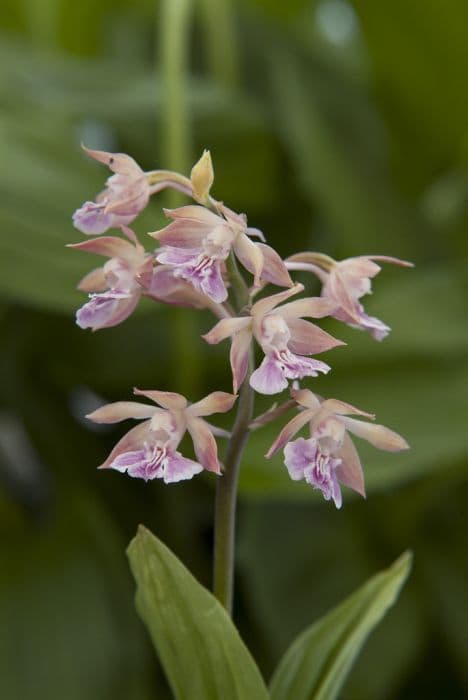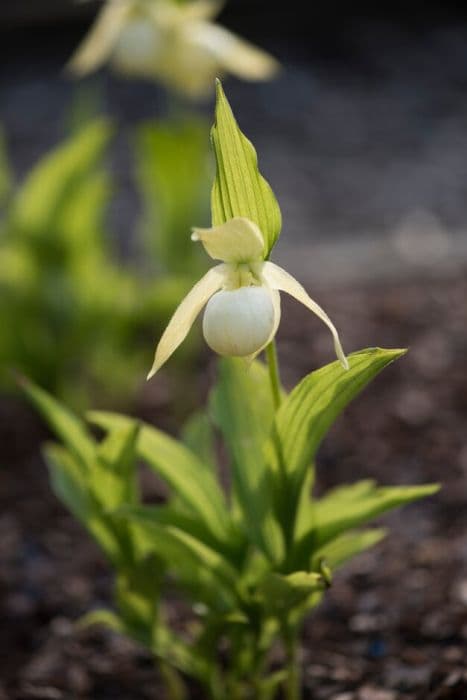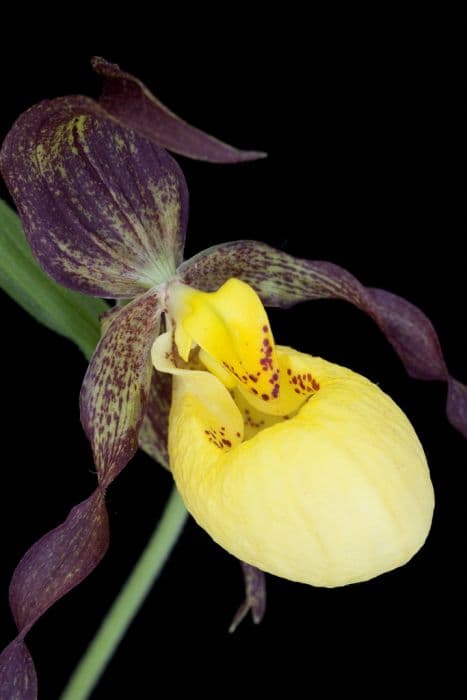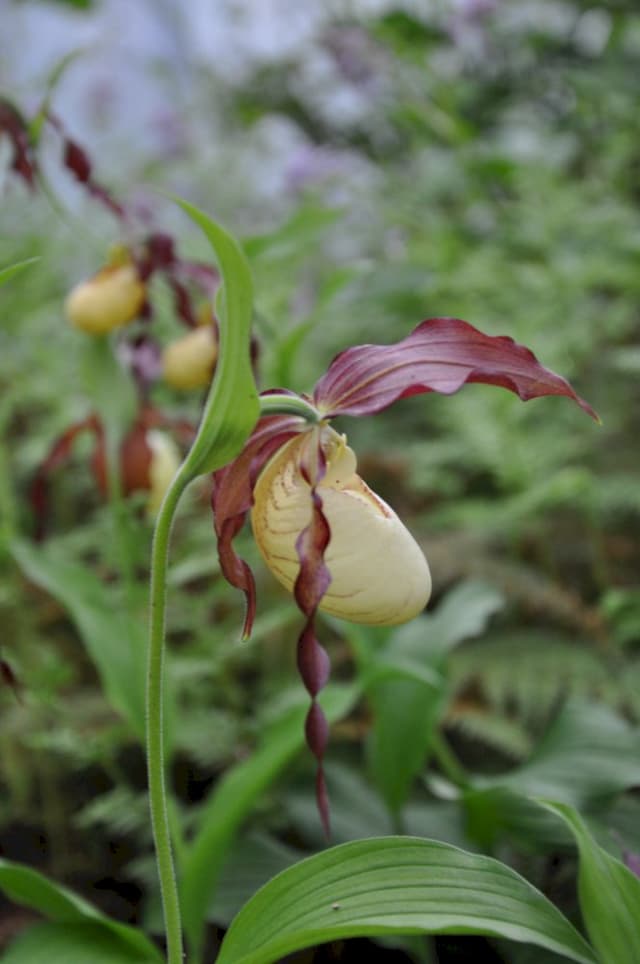Pleione Pleione Shantung gx 'Muriel Harberd'

ABOUT
The Pleione Shantung gx 'Muriel Harberd', commonly known as the Windowsill Orchid, boasts a striking appearance that can catch the eye of any plant enthusiast. This orchid typically has a pseudobulb from which its leaves and flowers emerge. The leaves are slender and elongated, often presenting in a lush green that supports the visual display of the flowers. The flowers themselves are the standout feature of this orchid, with their distinct shape and vibrant colors. The blossoms of the Windowsill Orchid can exhibit a range of colors, usually with a combination that may include shades of pink, purple, and white. They have a complex structure common to many orchids, with petals and sepals that spread out around a central lip, often called the labellum. This labellum may have different coloring or markings and is critical for attracting pollinators. The texture of 'Muriel Harberd' flowers is also noteworthy, with some parts potentially showing a delicate, almost crystalline appearance, while others might have a more velvety feel. The plant typically produces its blooms in a season where they will show for several weeks, offering an eye-catching display of beauty. Overall, the Windowsill Orchid is a compact, yet showy plant, known for its attractive foliage and stunning, long-lasting flowers.
About this plant
 Names
NamesFamily
Orchidaceae
Synonyms
Windowsill Orchid, Indian Crocus
Common names
Pleione Shantung gx 'Muriel Harberd'.
 Toxicity
ToxicityTo humans
The Pleione, commonly known as the Windowsill Orchid, is generally not considered toxic to humans. Consequently, accidental ingestion of parts of this plant typically does not lead to severe poisoning or life-threatening symptoms. However, as with any non-food plant, ingestion can potentially cause mild stomach upset or discomfort.
To pets
The Windowsill Orchid is not known to be toxic to pets. It is not typically associated with serious health issues if ingested by animals such as cats and dogs. Despite this, ingestion of non-food plants can still lead to gastrointestinal irritation or discomfort in some pets, so it is always prudent to discourage your pets from eating ornamental plants.
 Characteristics
CharacteristicsLife cycle
Perennials
Foliage type
Deciduous
Color of leaves
Green
Flower color
Varies
Height
1 foot (30 cm)
Spread
1 foot (30 cm)
Plant type
Bulb
Hardiness zones
9
Native area
China
Benefits
 General Benefits
General Benefits- Ornamental Value: Pleione, also known as the Windowsill Orchid, is prized for its beautiful and unique flowers, which can enhance the aesthetic appeal of any space.
- Easy to Grow Indoors: This orchid variety is well-suited to indoor cultivation, often thriving on windowsills with adequate light.
- Compact Size: The small stature of the Pleione makes it ideal for those with limited space or who prefer smaller houseplants.
- Seasonal Interest: Pleione typically blooms in the spring, providing a seasonal display of color and interest in the home.
- Hobby Interest: Orchid enthusiasts and hobbyists often enjoy growing Pleione species for their unique characteristics and the challenge they present.
 Medical Properties
Medical PropertiesThis plant is not used for medical purposes.
 Air-purifying Qualities
Air-purifying QualitiesThis plant is not specifically known for air purifying qualities.
 Other Uses
Other Uses- Pleione, also known as the Windowsill Orchid, can be used for terrariums due to their small size and humidity requirements, adding an exotic touch to a contained ecosystem.
- The plant's petals can be used in crafting for making realistic-looking artificial flowers because of Pleione's intricate and delicate blooms.
- As an educational tool in botany classes to demonstrate the life cycle and growth of orchids, highlighting the sympodial growth pattern that is characteristic of some orchid species.
- The Windowsill Orchid is suitable for bonsai arrangements, bringing a unique orchid variety into the traditional art form of miniature tree shaping.
- The flowers can be used in photography projects, offering a vibrant and detailed subject for macro photography enthusiasts.
- They can act as natural confetti in eco-friendly celebrations where synthetic materials are avoided, as the petals are biodegradable and present less environmental impact.
- In a floral color palette garden, Windowsill Orchids provide a pop of color in early spring when many plants have not yet bloomed.
- Used in corsages or boutonnieres for special events, Pleione flowers can bring a touch of elegance and exotic flair to attire.
- The plant can serve as a natural barometer, as some growers suggest Pleione buds can hint at upcoming weather changes based on their blooming behavior.
- Orchid enthusiasts sometimes use Pleione's fine roots as an example to teach proper repotting techniques for orchids with delicate root systems.
Interesting Facts
 Feng Shui
Feng ShuiThe Pleione is not used in Feng Shui practice.
 Zodiac Sign Compitability
Zodiac Sign CompitabilityThe Pleione is not used in astrology practice.
 Plant Symbolism
Plant Symbolism- Beauty and Refined Elegance: Pleione, often referred to as the Windowsill Orchid, epitomizes beauty and elegance, mirroring the stunning aesthetics of orchids in general, which are often associated with sophistication and exotic charm.
- Rebirth and Renewal: The Windowsill Orchid, like many orchids, has a growth cycle that includes a period of dormancy followed by a resurgence of growth and flowering. This cycle symbolizes rebirth and new beginnings.
- Overcoming Challenges: Orchids are known to grow in difficult environments, often where other plants cannot thrive. The Windowsill Orchid's resilience is a testament to overcoming challenges and flourishing despite adversity.
- Fertility and Abundance: The prolific blooming nature of the Windowsill Orchid can symbolize fertility and abundance, making it a positive emblem in contexts that celebrate growth or productivity.
 Water
WaterThe Pleione, commonly known as the Windowsill Orchid, should be watered sparingly, allowing the compost to nearly dry out before watering again; an average of once per week is a good guideline. During the growing season, from spring through fall, increase watering to maintain slight moisture, using about 8-12 ounces per week depending on the size of the pot and the humidity of your environment. In the winter, reduce watering significantly to once every 2-3 weeks since the plant will be in its dormant phase. Always ensure that the water does not sit in the crown of the plant as this can cause rot.
 Light
LightWindowsill Orchids require bright, indirect light to thrive, making an east or west-facing windowsill an ideal spot. They should be protected from the harsh midday sun, so if you only have a south-facing window, use a sheer curtain to diffuse the light. Insufficient light will lead to weak growth, while too much direct sunlight can scorch the leaves.
 Temperature
TemperatureWindowsill Orchids prefer moderate temperatures, with an ideal range between 55 to 75 degrees Fahrenheit. They can survive minimum temperatures of 50 degrees Fahrenheit during their dormant phase in winter but should not be subjected to temperatures below this point. Avoid placing your orchid near heat sources or drafts, as extreme temperature fluctuations can be harmful.
 Pruning
PruningPrune the Windowsill Orchid to remove any dead or damaged pseudobulbs and spent flower stems, which helps to encourage healthy growth and prevent disease. This is typically done after flowering or during repotting. Pruning is done on an as-needed basis rather than on a regular schedule. The best time for pruning is usually in the fall when the orchid has finished its blooming cycle.
 Cleaning
CleaningAs needed
 Soil
SoilThe best soil mix for Pleione (also known as the Windowsill Orchid) is a well-draining mix with equal parts of fine pine bark, perlite, and sphagnum moss. The soil pH should be slightly acidic, ranging between 5.5 to 6.5. This orchid thrives in dappled light with good air circulation around the roots.
 Repotting
RepottingWindowsill Orchids should be repotted annually, best done after the flowering season when new growth begins. This helps to refresh the growing medium and accommodate the new roots, preventing root rot and maintaining plant health.
 Humidity & Misting
Humidity & MistingWindowsill Orchids prefer high humidity levels, ideally between 60% to 80%. They thrive in moist air conditions, which mimic their native habitat, but do not like to sit in water or have wet roots for prolonged periods.
 Suitable locations
Suitable locationsIndoor
Place in bright indirect light, ensure high humidity.
Outdoor
Shelter from direct sun; protect from frost and strong winds.
Hardiness zone
9-10 USDA
 Life cycle
Life cycleThe life of a Pleione, commonly known as the Windowsill Orchid or Indian Crocus, begins with the germination of seeds, which, due to their symbiotic relationship with fungi, can be a challenging process. Upon successful germination and with appropriate care, the seedling develops into a young plant with a pseudobulb, which serves as a storage organ. Each year, the pseudobulb gives rise to a single leaf and potentially a flower stem, with striking blooms appearing in spring or autumn, depending on the species and cultivar. After flowering, the pseudobulb enters a period of dormancy, during which the existing leaf dies back, and the plant rests. A new pseudobulb then starts to develop, which will spring to life in the next growing season, continuing the growth cycle. This cycle of growth, flowering, and dormancy repeats yearly, with the mature plant capable of producing offsets or additional pseudobulbs to propagate and expand its presence.
 Propogation
PropogationPropogation time
Spring-Early Summer
The Pleione Shantung 'Muriel Harberd,' commonly known as the pleione orchid, is typically propagated through division. This process usually takes place after the flowering season when the plant is not actively growing, often in late summer to fall. To propagate pleione orchids by division, carefully remove the orchid from its pot and gently separate the pseudobulbs, ensuring that each new section has at least one growth bud. After separation, pot each pseudobulb in well-draining orchid media. This method allows for the quick establishment of new plants, replicating the parent plant's characteristics. It is important to maintain high humidity and appropriate temperature to encourage growth and rooting of the newly potted divisions.









